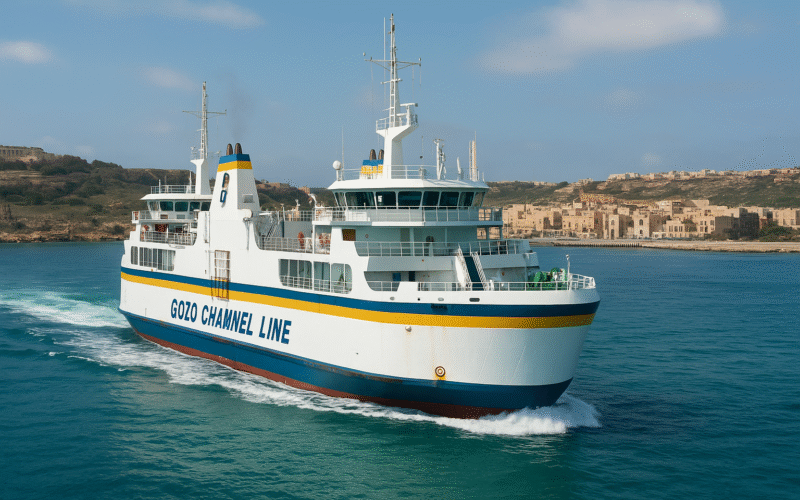When the Gozo Channel ferry service slows down, both Malta and Gozo feel the ripple. Vehicles queue at Mġarr and Ċirkewwa, commuters arrive late, and businesses are forced to adjust deliveries. The recent protests over unpaid allowances have once again highlighted how central this short stretch of sea is to daily life. The ferry is not just a crossing; it is part of the islands’ heartbeat.
Current Happenings
Workers, including mooring staff and cleaners employed through subcontractors, have begun go-slow directives in protest over unpaid allowances and wage differences. These actions have caused longer turnaround times, vehicle queues stretching for hours, and unexpected delays for residents and visitors. Some passengers have reported waiting for up to two hours, with onboard facilities and maintenance affected due to staff shortages.
The impact is visible across both islands. Every delay at the terminals translates into a slowdown in business, tourism, and family life.
Hvorfor det er vigtigt
Gozo Channel is the main artery linking Malta and Gozo. It carries people, private cars, vans, trucks, and essential freight almost non-stop. When part of the crew holds back from duties or when a vessel operates below capacity, turnaround time increases and the queues grow quickly.
Demand for crossings keeps rising while the infrastructure remains largely the same. Each minute lost in turnaround now has a much bigger effect than it did even a few years ago.
The Numbers Behind the Traffic
The data tells the story.
- In one quarter of 2024, the service handled more than 1.6 million passengers on over 11,000 sailings.
- In 2025, the numbers climbed even higher, with nearly 1.9 million passengers and more than half a million vehicles in a single quarter.
- Around 85 to 90 percent of all passenger traffic between the islands still depends on the car ferry service.
These figures confirm that the Gozo Channel remains the backbone of everyday mobility for commuters, families, and businesses.
The Fast Ferry: Helpful, but not Enough
The fast ferry between Mġarr and Valletta has become a lifeline for foot passengers. It is quick, comfortable, and offers a scenic commute. Yet it cannot carry vehicles, and that is where the bottleneck remains. Families with children, contractors with tools, and visitors with rental cars all rely on the main ferry.
When strong winds or rough seas arrive, the fast ferry is often suspended, pushing even more passengers back to the Gozo Channel. It is an excellent supplement, but not a full solution.
Everyday impact for residents, workers, and visitors
Daily travellers must now allow more time. A late ferry can mean a missed meeting, class, or medical appointment. Adding thirty minutes to travel plans often makes all the difference.
Businesses depending on inter-island deliveries face higher costs and tight margins. Missed departures can disrupt service schedules and customer confidence, especially for small enterprises that operate across both islands.
Weekend visitors should plan ahead. Early Friday or late Sunday trips tend to be calmer. Travellers without cars can avoid the stress altogether by using the fast ferry when conditions allow.
What you can do
- Check Gozo Channel’s live schedule before leaving home and watch for official updates.
- If travelling without a car, use the fast ferry to skip the vehicle queues.
- Avoid peak hours such as Friday evening and Sunday night whenever possible.
- For business deliveries, build buffer time into your schedule and keep customers informed.
- Monitor weather forecasts and prepare for possible fast ferry cancellations.
- When industrial action is announced, consider moving essential travel to earlier crossings.
At gå på pension på Gozo: Ægte omkostninger, livskvalitet og skjulte udfordringer
Et kig fremad
Plans to expand the ferry fleet and upgrade terminals are on the government’s agenda. Discussions on introducing a new vessel and investing in better port infrastructure are ongoing. EU funding may support improvements such as smarter ticketing systems and modernised docking facilities.
These are positive signs, but change takes time. Until then, the best strategy is patience, preparation, and a bit of flexibility.
Out Take
The Gozo Channel is far more than a transport service. It is the physical and economic link that keeps Malta and Gozo connected. When the service slows, it touches every part of island life. From commuters and business owners to tourists and residents, everyone feels the strain.
The recent protests are a reminder of how finely balanced this connection is. Until long-term improvements are in place, planning ahead is the best way to keep your travels smooth and your schedule intact.








